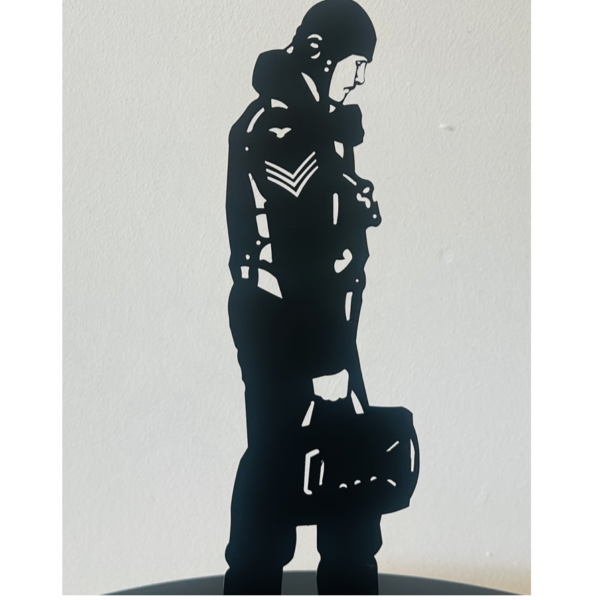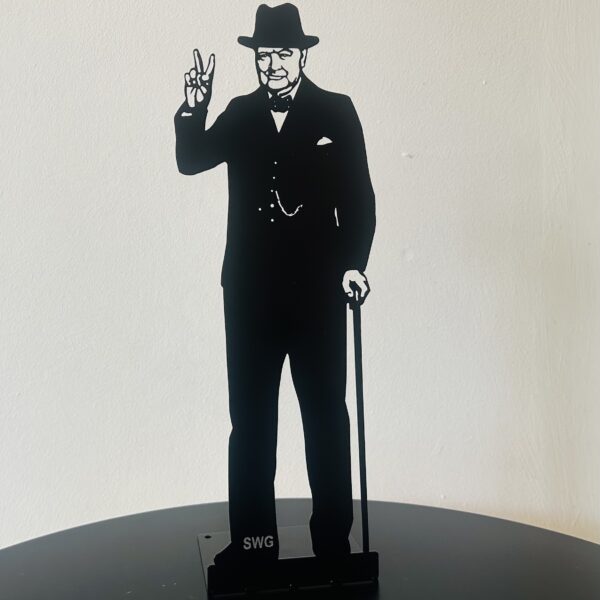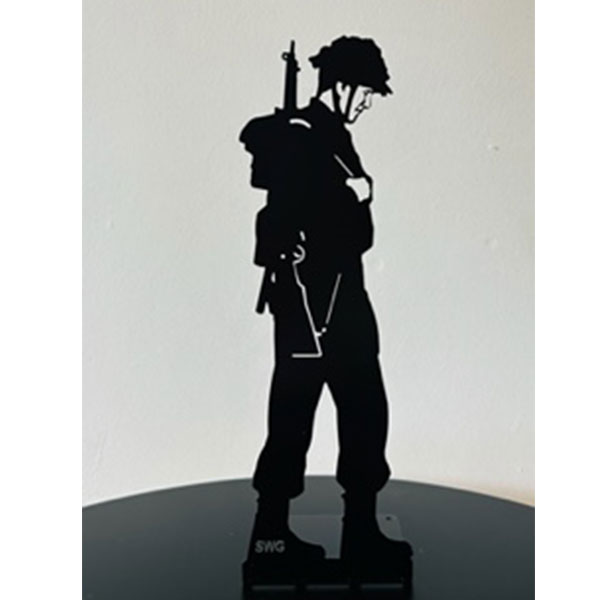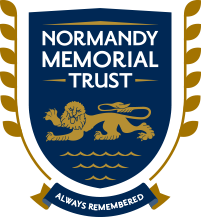
Henry (Harry) Cyril Langford
This story and photos are shared by the Trust with kind permission from Robert Langford, son of Henry Langford
My father, Harry C. Langford, had been a keen radio ham with his own transmitter. He joined the Royal Naval Volunteer Wireless Reserve and was called up in 1939. A few years escorting convoys from India to South Africa was followed by a move to HMS Victorious, an aircraft carrier. He gained experience with a seaborn landing on North Africa, when Victorious was used as one of the command ships.
Consequently, he was chosen to lead a team that would communicate with the landing craft and military for landing the 231st Brigade on Jig sector of Gold Beach. This was aboard HMS Nith, a frigate that was the command ship for that part of the beach. His letter home a few days after D-Day described how at dawn, they had crept close to the shore ready for the task ahead. He went on to describe how hectic it was and the noise was indescribable. They wondered if they would survive the day.
Hectic days followed. Harry writes seven days later:
“Today was seven days after “D” Day - I remember this time last week so vividly - the wonderment that after the initial assault, we were still alive and kicking - So much more danger seemed apparent and yet as the minutes, then hours, ticked away - I breathed again, I had time to think ‘Twas just like being reborn. - the briefing of the previous week had increased certain nervous activities and I presume the general dormant feeling prevailing three days afterwards, was due entirely to reaction; not the severe mental work of communication. - There’s no doubt now that in my inner mind I would not have missed this show for anything and I’m quite sure that all on board here felt a distinct thrill as we crept right into the French coast - close enough to see the church, houses and details of the district - and being one of the very first on the scene added much to the tension
Gee, I stood on the deck and could not believe my eyes. To have left English shores behind only the previous night, and now look on this much vaunted Western Wall: Well you can guess the rest - No panic, but everything burst and amidst the continual roar of the opening of the “D” Day - organisation was kept on top line. - I managed to hold my job down - although ‘twas hectic, and now seven days after - I sit once again on the mess-deck, writing. A thing I hardly dared to think of just a week ago
To lighten the subject - an amusing incident was the remark by the lady announcer on "Calais radio" at the end of that evenings programme (i.e. June 5th) was - Remember now - listen again tomorrow at 0600 etc - Don't forget "you’ve a date with me" - and did we keep it!"
HMS Nith then took charge of shipping traffic in and out of the Mulberry Harbour. A period of relative quiet set in. On 19th Harry wrote “….the time is 0559 on D Day plus 13 – I note that dawn and dusk is still a tricky time out here and I look forward to the day when jaded nerves can rest assured of a peaceful snooze. I noted Nigs (the ships black cat) asleep in a coil of rope when I came on watch and thought on the northern Nigs and the comfort of home regions”. Clearly he was feeling the strain of it all and feeling home sick for his black cat at Buckley.
In his next letter, on 22nd June, he talks about the aftermath of the great storm that hit the Normandy coast on 19-20 June: “…the weather on looking out is reminiscent of at least November and a bitterly cold dawn has set the choppy sea an example which causes it to take on a steel grey ruffled appearance. Still perhaps the wind which has howled through the rigging these last few days will have abated and ease the sufferings of those lads who, white of face, and uneasy of tummy have prowled the regions of utter dejection. I’ve enjoyed long spells on the upper – leaning on the wind, watching great breakers curling in toward the ship and feeling the might of water as she’s lifted. Motion which is agony for some but a relief from monotony to others- nuff said”
Harry started on his next letter home on the night of 23/24 June but he was never to finish it. In it he mentions a change in activity for those at sea off the Normandy coast as the battles moved on: “I have just spent two hours sunbathing on the upper, and watching all the activity of invasion - Still the work goes on and still unusual missions with either pleasant or otherwise results - Its amazing to see the great swarms of Allied aircraft shining silver in the sun, ploughing south into the country more inland - and the noise of battle has receded into the distance - rolling only this way as the breeze carries it.
There was little to talk about except these trivial things which tend to relieve the monotony. Nigs (the ship's cat) was still in evidence and yells just as any other cat when there’s fish around.
- Ah Warrant Ted has just come in with the news that there’s six bags of mail on board so you can imagine the nervous tension now. Three cheers”
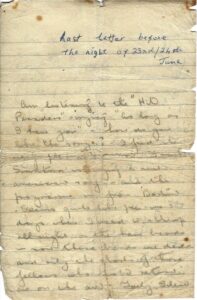
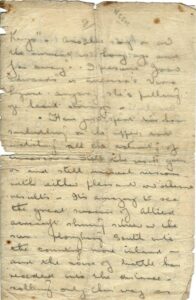

Harry's last letter home
However, risks were still there as those on HMS Nith were to discover. HMS Nith had painted her funnel and bridge structure to make themselves more prominent. Ordinary Seaman Les Gentry explained why: "After a few days, it seemed that in the heavy traffic it was difficult for incoming vessels to find the “Nith”. To overcome this, we painted the funnel and bridge structure in a bold red colour in order to make ourselves more prominent. This may have solved one problem but brought another, in as much that we began to receive attention from shore batteries along the coast. This caused no harm, and in any case stopped when a battle monitor was brought near to us."
On 24th June, after the ship had picked up a convoy from the rendezvous point in the English Channel and brought them into the beachhead to anchor and discharge their cargoes, they received a message to return home the following day so they could take on supplies and then return to duty off the Normandy coast.
The ship remained at action stations as usual that night but they were having issues with the radar set used to detect aircraft. Les Gentry explains why: "My action station was at the type 291 type radar set which designed to locate aircraft as opposed to surface objects and was located just below the bridge overhang on the port side. On this particular evening the set gave trouble from the beginning and I was given permission to close down the set and seek out the radar mechanic was situated in the starboard passage. I found him and it turned out he was extremely lucky to be taken from that area. Having applied his skills to the necessary repair he asked me to try it out. On my first sweep I reached the bearing dead astern, when I picked out an aircraft at thirteen thousand feet, range closing. I reported to the bridge and was told to hold. The bearing remained steady all the way to my last report, which was target overhead sir! This report was probably not heard on the bridge, as it coincided with an enormous explosion.”
The Luftwaffe were attempting to disrupt supplies reaching the beaches and the fact that HMS Nith had a red painted funnel suggested she was no ordinary ship and thus made her an obvious target. At 2300 the radar sets picked up three incoming aircraft, one of which was a new innovation, developed by the Germans, known as the Mistel.
The Mistel, or drone, was an experimental weapon. It was basically an unmanned bomber with a reinforced nose section filled with explosives that was tethered below a piloted fighter aircraft. The fighter pilot would align, and then release, the Mistel which would travel, on auto pilot, towards its target. The pilot of the fighter aircraft would then return to base.
The ME 109 approaching HMS NITH attracted anti-aircraft fire from the nearby ships. It was 2315 hrs and tension on the Nith mounted. Everyone was at action stations but where was the aircraft they had heard overhead?
First Lieutenant Peter Meryon was second in command of Nith. “My action station was on the new superstructure (altered considerably to accommodate the Brigadier’s war room and staff accommodation) and in the open air, about 100 feet from the bridge. I clearly remember that moonlight night, at action stations, hearing the droning of an enemy aircraft. Then I remember being aware of it aiming itself at us and the separating of the smaller aircraft above it. The aircraft continued on a descent towards us”.
The order “Open fire” was given on HMS NITH and the shells struck the Mistel but the wing of the aircraft hit the starboard side amidships and exploded. My father and his entire communications team were in their mess on the starboard side, prior to the change of watch at midnight, and it took the brunt of the explosion. They were all killed along with an artificer in the engine room.
The ship, although severely damaged, remained afloat. The wounded were transferred to a hospital LST, US 336, which took them back to the UK and HMS Nith was prepared for towing home for repairs. Work stopped at about 7am on the 25th June so they could bury the nine men who had been killed as a result of the attack. They were buried at sea off Arromanches.
HMS Nith was towed back to the UK on the 26th June but she returned to the battle on the 2nd August, in her role as HQ Ship for the Support Squadron of the Eastern flank. She was finally relieved on the 16th September and, after a long refit, was sent on operations against the Japanese. After the war she returned to the UK and entered the reserve fleet at Harwich before being sold to the Egyptian government in 1948. Renamed the Domlat, she was sunk by HMS Newfoundland during the Suez Crisis in 1956.
British Normandy Memorial - Additional Information
At total of 10 men were killed as a result of the attack by the Mistel. Ordinary Seaman Duckett had been amongst those who had been wounded and transferred to the LST on the 25th June. But he died of his wounds the next day and was buried in Southampton (Hollybrook) Cemetery.
FALLEN HEROES
HENRY CYRIL LANGFORD
Royal Navy • LEADING TELEGRAPHIST
Royal Naval Volunteer (Wireless) Reserve
HMS NithDIED | 24 June 1944
AGE | 26
SERVICE NO. | D/WRX 968
BRYAN JOHNSON BUTTERWORTH
Royal Navy • TELEGRAPHIST
Royal Navy
HMS NithDIED | 24 June 1944
AGE | 19
SERVICE NO. | D/JX 574758
CYRIL WILLIAM DUCKETT
Royal Navy • ORDINARY SEAMAN
Royal Navy
HMS NithDIED | 26 June 1944
AGE | 19
SERVICE NO. | C/JX 408436
GEORGE JOSEPH DURKIN
Royal Navy • ORDINARY TELEGRAPHIST
Royal Navy
HMS NithDIED | 24 June 1944
AGE | 17
SERVICE NO. | D/JX 578987
FRANK HENRY ELKES
Royal Navy • TELEGRAPHIST
Royal Navy
HMS NithDIED | 24 June 1944
AGE | 22
SERVICE NO. | D/JX 271797
HARRY FISH
Royal Navy • CODER
Royal Navy
HMS NithDIED | 24 June 1944
AGE | 33
SERVICE NO. | D/JX 230450
TERENCE EDWIN JAMES JENSEN
Royal Navy • ORDINARY TELEGRAPHIST
Royal Navy
HMS NithDIED | 24 June 1944
AGE | 18
SERVICE NO. | C/JX 610538
JAMES KEENAN
Royal Navy • TELEGRAPHIST
Royal Navy
HMS NithDIED | 24 June 1944
AGE | 29
SERVICE NO. | D/JX 258050
RICHARD LONGSTAFF
Royal Navy • CODER
Royal Navy
HMS NithDIED | 24 June 1944
AGE | 35
SERVICE NO. | C/JX 293635
REGINALD STANLEY TUCKER
Royal Navy • ENGINE ROOM ARTIFICER 3RD CLASS
Royal Navy
HMS NithDIED | 24 June 1944
AGE | 24
SERVICE NO. | C/MX 52279
FALLEN HEROES
HENRY CYRIL LANGFORD
Royal Navy • LEADING TELEGRAPHIST
Royal Naval Volunteer (Wireless) Reserve
HMS NithDIED | 24 June 1944
AGE | 26
SERVICE NO. | D/WRX 968
BRYAN JOHNSON BUTTERWORTH
Royal Navy • TELEGRAPHIST
Royal Navy
HMS NithDIED | 24 June 1944
AGE | 19
SERVICE NO. | D/JX 574758
CYRIL WILLIAM DUCKETT
Royal Navy • ORDINARY SEAMAN
Royal Navy
HMS NithDIED | 26 June 1944
AGE | 19
SERVICE NO. | C/JX 408436
GEORGE JOSEPH DURKIN
Royal Navy • ORDINARY TELEGRAPHIST
Royal Navy
HMS NithDIED | 24 June 1944
AGE | 17
SERVICE NO. | D/JX 578987
FRANK HENRY ELKES
Royal Navy • TELEGRAPHIST
Royal Navy
HMS NithDIED | 24 June 1944
AGE | 22
SERVICE NO. | D/JX 271797
HARRY FISH
Royal Navy • CODER
Royal Navy
HMS NithDIED | 24 June 1944
AGE | 33
SERVICE NO. | D/JX 230450
TERENCE EDWIN JAMES JENSEN
Royal Navy • ORDINARY TELEGRAPHIST
Royal Navy
HMS NithDIED | 24 June 1944
AGE | 18
SERVICE NO. | C/JX 610538
JAMES KEENAN
Royal Navy • TELEGRAPHIST
Royal Navy
HMS NithDIED | 24 June 1944
AGE | 29
SERVICE NO. | D/JX 258050
RICHARD LONGSTAFF
Royal Navy • CODER
Royal Navy
HMS NithDIED | 24 June 1944
AGE | 35
SERVICE NO. | C/JX 293635
REGINALD STANLEY TUCKER
Royal Navy • ENGINE ROOM ARTIFICER 3RD CLASS
Royal Navy
HMS NithDIED | 24 June 1944
AGE | 24
SERVICE NO. | C/MX 52279




